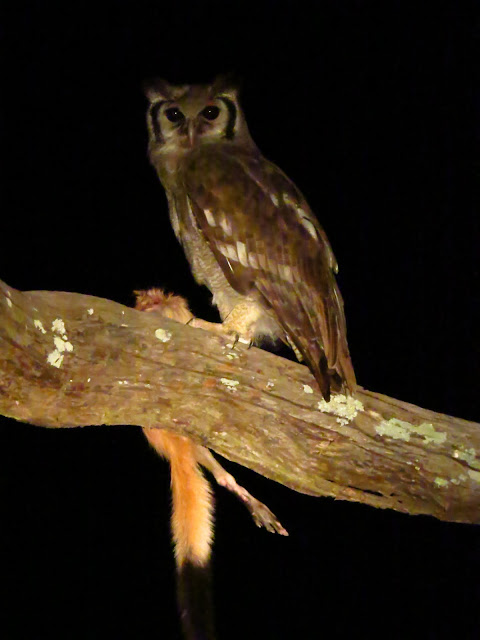For our Youth Day (16 June) long weekend we decided to visit the far north of Kruger National Park for some birding. We left in the late afternoon of Thursday and after a rather unpleasant drive on the N1 (lots of roadworks and long weekend traffic) we arrived late evening at Avoca Vale hotel in the mountains above Makhado (Louis Trichardt). The place was a bit run down and located right on the highway (so a bit noisy) but we were tired and didn't really care so went straight to bed.
16 June
We were up at 03:30 and on the road by 4am for the 2-hour drive to Pafuri gate. We were the first to arrive at the gate, just before 6am and we waited patiently (gates open at 6am in winter) listening to the first bird calls. Six o'clock came and went but there was no activity around the gate compound. At 06:10, a quick hoot on the horn roused a sleepy security guard who rudely asked me what I wanted. I told him they need to open the gate so we can enter the park. He asked me "Why?". I said because it's past 6am and the gates are supposed to be open. Then he had the audacity to ask me "What is your problem?" On the verge of climbing the gate and having a go at the guard, he quickly disappeared and moments later came out again to open the gate. I was livid at this guy's insolence but decided to enjoy our weekend instead and deal with the issue later.
 |
| White-crowned lapwing |
 |
| White-fronted bee-eaters |
Conditions were overcast and windy and birding along the road was
limited to the occasional bird parties we came across. These always
contained Fork-tailed drongos, Southern black tits, Cinnamon-breasted
buntings, Emerald-spotted wood doves, Blue waxbills, Greater blue-eared
or Meves's starlings, a hornbill or two and one or both possible
tchagras (Brown- and Black-crowned). By the time we reached the Levhuvhu
river, the weather had improved marginally and the proximity to water
also helped to improve the quality of the birding. The first surprise
was a coucal that, upon realizing that it was quite large, lacked
barring on the rump and streaks on the side of the neck, warranted
closer inspection, and was confirmed as a Senegal coucal. At the bridge
we saw Mottled spinetail, Woolly-necked stork, Giant kingfisher,
White-fronted bee-eater, Southern boubou, Little swift, Wire-tailed
swallow and Red-billed buffalo weaver. At Pafuri picnic site we added
African paradise flycatcher, African pied wagtail, White-crowned
lapwing, Three-banded plover, African green pigeon, Collared sunbird,
Yellow-breasted apalis, African yellow white-eye, Brown-headed parrot
and Green-backd camaroptera. By mid-afternoon we started heading south
towards Punda Maria and added a few more birds along the way, notably
Double-banded sandgrouse, Wattled starling, Black saw-wing,
Yellow-bellied greenbul, Jameson's firefinch and Brown snake-eagle. We
drove into the Punda Maria camp just after 5pm, checked in and started
cooking dinner almost immediately.
 |
| Dickinson's kestrel |
After dinner we relaxed a little before walking back up to reception
just before 8pm for the night drive we booked. We were ecstatic to
discover we're the only people on the vehicle and with our request for
night birding firmly placed with our ranger, we drove out the gate. It
was quite a successful drive with fantastic views up close and personal
of two male lions, less than 2m from our vehicle, herds of elephant and
buffalo, large spotted genet, numerous spring hare and a skulking civet.
Birding wise we picked up a beautiful Verreaux's eagle-owl and heard
African scops owl several times. Just after 10pm we returned and
collapsed into bed.
 |
| One of two brothers seen on our night drive |
 |
| Verreaux's eagle-owl with a spring hare for dinner |
17 June
Out the gate almost when it opened at 6am, we headed
back towards Pafuri, birding slowly along the way. There wasn't much new
for the trip but when we reached the Pafuri picnic site by lunch time,
we'd had a very enjoyable morning's birding. Around Pafuri we had good
views also of African hawk-eagle, Green-winged pytilia, Brown-necked
(Grey-headed) parrot, Saddle-billed stork, Red-capped robin-chat,
White-browed robin-chat and Village indigobird. Mid-afternoon we turned
south again and arrived back at Punda Maria in time for a pleasant
dinner in the restaurant.
 |
| African hawk-eagle |
 |
| Brown-necked (Grey-headed) parrot |
18 June
A cold front seems to have arrived as it was noticeably
colder this morning and clouds started gathering after 7am. Since we
had a long drive back, we decided to just bird the loop west of Punda
Maria and then head home. Despite the chill in the air, birding was
excellent and apart from the common expected birds we also logged
Yellow-bellied greenbul, Golden-tailed, Cardinal and Bearded
woodpeckers, Brown-headed parrot, Sabota lark, African green pigeon,
Orange-breasted bushshrike, Yellow-breasted apalis, Scarlet-chested
sunbird, Mosque swallow and Crowned hornbill. By 10am we exited the park
and took the backroads via Giyani and Lydenburg to get home just before
5pm.
 |
| Female Double-banded sandgrouse |
 |
| Mosque swallow |
 |
| Male Double-banded sandgrouse |
We ended the weekend with 125 species on the list - really not a bad effort considering it's mid-winter and the weather wasn't ideal. Pafuri always produces great birding and since it's so far, there are always far fewer people too. We'll be back soon!

















